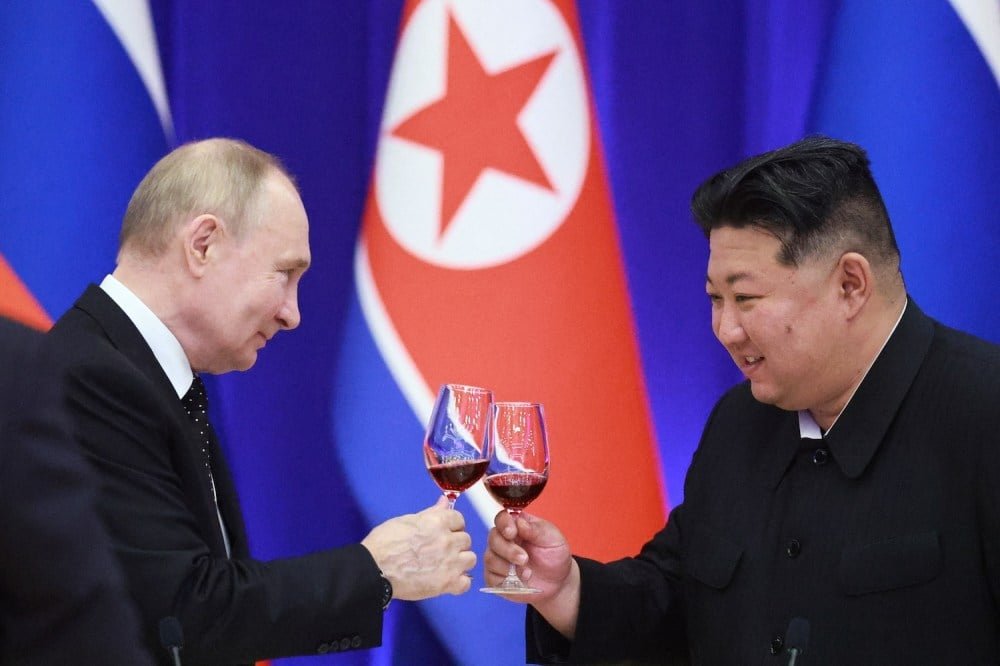Can Trump Drive a Wedge Between Russia and North Korea?
Moscow, Pyongyang, Beijing, and Tehran have formed an alliance of convenience. Ending the Ukraine war could disrupt it.

By Matthew Kroenig, a columnist at Foreign Policy and vice president and senior director of the Atlantic Council’s Scowcroft Center for Strategy and Security.

Russian President Vladimir Putin and North Korean leader Kim Jong Un toast during a reception at the Mongnangwan Reception House in Pyongyang on June 19. Vladimir Smirnov/AFP via Getty Images
In recent weeks, North Korea deployed troops to Russia to reinforce Vladimir Putin’s invasion of Ukraine. This is only the latest example of the increased collusion among the new Axis of Aggression: China, Iran, North Korea, and Russia.
How can the new Trump administration address this challenge?
In recent weeks, North Korea deployed troops to Russia to reinforce Vladimir Putin’s invasion of Ukraine. This is only the latest example of the increased collusion among the new Axis of Aggression: China, Iran, North Korea, and Russia.
How can the new Trump administration address this challenge?
While the Trump 2.0 National Security Strategy has yet to be written, a major part of the answer will center on the president-elect’s promise to bring a quick end to the war in Ukraine.
The interlinkages among this Axis of Aggression are not as deep and robust as some might think. Rather, almost all of the ties revolve around the other dictators supporting Putin’s war against Ukraine.
North Korea is providing troops and munitions. Iran is providing drones. China is providing enormous economic support short of lethal military assistance, including the heavy-duty trucks and excavation equipment that are allowing Putin to literally dig in to Russian-occupied Ukraine. In exchange for this largesse, it is rumored that Russia is providing advanced military assistance related to nuclear weapons and space technology.
Apart from backing Putin’s war against Russia, however, the ties among these dictators are sparse. To be sure, there would remain a general antagonism to the U.S.-led, post-World War II international system, but the near-term, life-or-death incentives for urgent military collaboration would be removed.
Bringing the war in Ukraine to a quick and decisive conclusion, therefore, as Donald Trump has promised to do, would remove many of the incentives for autocratic collaboration.
This would provide time and space for the natural enmities among these dictators to emerge, providing Washington and the free world with the opportunity to develop a coherent long-term strategy to counter, deter, and if necessary defeat the Axis of Aggression at the same time.
This post is part of FP’s live coverage with global updates and analysis throughout the U.S. election. Follow along here.
Matthew Kroenig is a columnist at Foreign Policy and vice president and senior director of the Atlantic Council’s Scowcroft Center for Strategy and Security and a professor in the Department of Government and the Edmund A. Walsh School of Foreign Service at Georgetown University. His latest book, with Dan Negrea, is We Win, They Lose: Republican Foreign Policy and the New Cold War. X: @matthewkroenig
More from Foreign Policy

Russia Can’t Keep Spending Like This for Long
Moscow is depleting its rainy-day savings to plug its war-induced fiscal deficit while preserving social stability.

The Next AI Debate Is About Geopolitics
Data might be the “new oil,” but nations—not nature—will decide where to build data centers.

The Enduring Mystery of Trump’s Relationship With Russia
After years of government investigations, we still don’t know if the former president is actually in Putin’s pocket.

The Case for the Greater West
Washington should abandon liberal universalism and work with the empire it already has.
Trending
![]()
Sign up for World Brief
FP’s flagship evening newsletter guiding you through the most important world stories of the day, written by Alexandra Sharp. Delivered weekdays.
By submitting your email, you agree to the Privacy Policy and Terms of Use and to receive email correspondence from us. You may opt out at any time.
